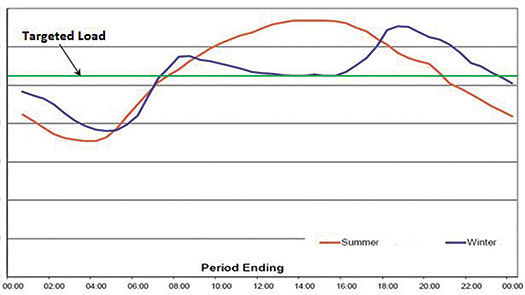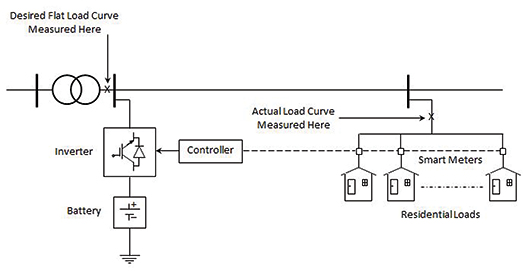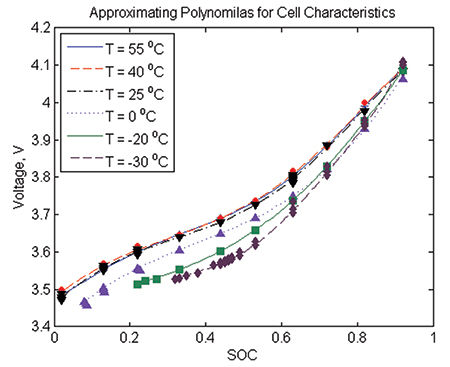In modern power systems, energy storage has become imperative because of the increasing penetration of renewable sources, distributed generation and microgrids. Energy storage elements, such as supercapacitors, flywheels, batteries and pumped hydro, help increase energy sustainability and improve supply reliability. Lithium-ion batteries provide an excellent compromise between performance, cost and lifetime among other storage technologies. Batteries can generally represent outstanding solutions for short-, medium- and long-term energy storage requirements.
On the other hand, fluctuations in the daily demand profile of almost all types of loads have been a hindrance to distribution system operators and planners. The system is usually designed based on the maximum load demand, but such capacity is not utilized all the time. Distribution transformers, feeders and substations are accordingly rated at a higher level than the average load they serve. Therefore distribution system personnel have always sought to have a flat demand profile for the sake of better employment of system capacity. This goal has recently become achievable via new developments in the field of energy storage technologies.

This objective is clearly defined as to reshape the daily load profile to a flat curve without the classical hills and valleys. Reshaping the load curve in such a way is possible if an energy storage element charges during off-load periods and discharges during load periods. An excellent candidate to undertake this function is a lithium-ion battery, which is known for its high energy density, low self-discharge rate and long lifecycle. An ongoing research project at Ryerson University’s Centre for Urban Energy (CUE) aims to find a technical solution to the problem of load curve fluctuations using lithium-ion battery systems. The solution is intended to be mounted on a distribution pole at the secondary side of a 50 kVA transformer that is feeding residential customers.

The research project involves the design, development, testing and installation of a technical solution based on lithium-Ion batteries for the reliability improvement of local distribution companies (LDCs). An energy storage system based on lithium-ion batteries will be interfaced to the distribution network through an inverter/ charger unit. The inverter will allow bidirectional power flow. The battery will be optimally scheduled to produce a new transformer load curve that is as close as possible to the absolute flat curve. The practical limitations on the battery power and energy capacities make it difficult to attain the absolute flat load profile. Therefore, the result is that the overall load curve incorporating both the residential customers and the new energy storage system together will look more uniform.
From the distribution network point of view, the discrepancy between minimum and maximum load values over the 24 hour period of the day will be minimized. To achieve such a goal, an intelligent controller is developed on a PC which communicates with peripheral devices, including the smart meter at the load terminals, in order to continuously acquire load data. The system is developed in a laboratory environment on a single-phase basis. Extensive laboratory testing will be carried out before a prototype is installed on an actual distribution grid. The solution will be monitored for daily operation and data acquisition for reasonable time before the technology gets marketed.
Partners on this project are Ryerson University, eCamion, and Toronto Hydro. Researchers at CUE will develop the intelligent control algorithm and test the system in the laboratory at commercial scales. Technical staff at eCamion will design and produce the casing and HVAC unit in addition to providing the battery packs required by the system. Toronto Hydro will advise on a suitable installation site, where the final prototype will be mounted on a pole top, and will monitor the performance of the system over a prescribed testing period. Finally, eCamion will be responsible for the marketing of the new technology after field testing assures the technical feasibility of the final product.
With minor modifications to the system ratings and control algorithm, the final prototype will be able to serve other distribution system purposes as well. A sample list of such purposes includes:
- Enhancement of the supply reliability
- Operation in isolated microgid mode
- Grid frequency support
- Voltage sag compensation
- Enhancement of system stability
The system under consideration comprises a lithium-ion battery interfaced to the distribution network at the secondary terminals of the transformer through an inverter/charger unit. The solution also requires online monitoring of the load condition and a smart algorithm which utilizes the available energy of the battery in an optimal manner. Online load monitoring is possible through communication with the smart meter at the load terminals. Information about the status of both battery and inverter is also available through communication with both devices. Then, an intelligent algorithm can decide on the required operational parameters in order to optimally utilize the available energy in the battery at a given time. A proper command will be issued and communicated to the inverter. A host PC will communicate with all system components and run the smart control algorithm to schedule the battery 24 hours ahead of time. The scheduling job requires a reliable load forecasting technique to be developed in order to anticipate the load profile of the following day.
Due to the complex behaviour of lithium-ion battery cells, a battery management system (BMS) is typically required to regulate the performance. Accurate estimation of the battery state of charge (SOC) is vital for appropriate operation of the BMS. The industry uses standard methods to monitor the SOC such as Coulomb counting and open circuit voltage (OCV). The Coulomb counting method depends on estimating the SOC at an initial point, then integrating the charging or discharging current with respect to time in order to account for the added or subtracted charge. The method is inaccurate because of the accumulating error of the Coulomb counting process. On the other hand, despite the higher accuracy, measurement of the OCV is impossible until a rest position is reached where the battery is in an idle mode. Nevertheless, both methods usually neglect the effects of cell imbalance and temperature, which adds to the inherent inaccuracy.
To estimate the SOC of a lithium-ion battery pack, it is strongly believed that working at the cell level will increase the estimation accuracy. The cell characteristics which relate the OCV to the SOC at different temperatures are normally provided by the manufacturer. Testing of an individual cell at different temperatures yields discrete measurements of OCV versus SOC. The challenge is to use the manufacturer supplied characteristics to develop an intelligent model which yields the cell SOC at any given OCV and temperature. This work involves the design, development, training, and testing of an intelligent cell model based on adaptive neuro-fuzzy inference systems (ANFIS) which will eventually serve to enhance the estimation accuracy of the battery SOC. The new ANFIS model of cell characteristics as employed in the estimation of the battery SOC is one of the contributions of the present project.

The technology developed in this project provides many advantages to distribution utilities. A straightforward gain will be the reduction of capacity of distribution system components used to feed residential customers including pole-top transformer, feeder cable, voltage regulators, distribution substation and switchgear elements. The capital cost of future distribution grids will be reduced accordingly. In addition, network components will be operating at or around their nameplate ratings such that reduced-capacity operation will be avoided. The technology makes use of the communication strength of smart grid elements such as smart meters which are already deployed in Ontario. The site testing results are expected to gain the trust of other distribution utilities leading to mass production and eventual cost reduction of the product.
About the Authors
 Dr. Bala Venkatesh is both founding Academic Director and head of the Ryerson Centre for Urban Energy (CUE). He currently serves as a Professor of Electrical Engineering at Ryerson and has also taught at the University of New Brunswick, Multimedia University (Malaysia), and Anna University (India). He has published more than 100 articles in journals and conferences and has supervised 34 MASc and PhD theses. In total, his extramural funding is more than 10 million dollars. He is a registered professional engineer in Ontario and, in the last two decades, has worked on over 10 consulting projects in India and Canada.
Dr. Bala Venkatesh is both founding Academic Director and head of the Ryerson Centre for Urban Energy (CUE). He currently serves as a Professor of Electrical Engineering at Ryerson and has also taught at the University of New Brunswick, Multimedia University (Malaysia), and Anna University (India). He has published more than 100 articles in journals and conferences and has supervised 34 MASc and PhD theses. In total, his extramural funding is more than 10 million dollars. He is a registered professional engineer in Ontario and, in the last two decades, has worked on over 10 consulting projects in India and Canada.
 Dr. Mohamed Awadallah is a research fellow with the Centre for Urban Energy (CUE) at Ryerson University. He works on government- and industry-funded research projects related to power distribution systems, with emphasis on renewable energies, energy storage and smart grid. Before joining CUE in July 2013, he was Head of Electrical Power Engineering Department, Yanbu Industrial College, Saudi Arabia. He has more than twenty years of academic experience along the research, teaching and leadership axes. He authored and coauthored more than fifty research publications. He is a member of the honour societies of Eta Kappa Nu, Tau Beta Pi, and Phi Kappa Phi. He is a Registered Professional Engineer in the Province of Ontario, Canada.
Dr. Mohamed Awadallah is a research fellow with the Centre for Urban Energy (CUE) at Ryerson University. He works on government- and industry-funded research projects related to power distribution systems, with emphasis on renewable energies, energy storage and smart grid. Before joining CUE in July 2013, he was Head of Electrical Power Engineering Department, Yanbu Industrial College, Saudi Arabia. He has more than twenty years of academic experience along the research, teaching and leadership axes. He authored and coauthored more than fifty research publications. He is a member of the honour societies of Eta Kappa Nu, Tau Beta Pi, and Phi Kappa Phi. He is a Registered Professional Engineer in the Province of Ontario, Canada.







